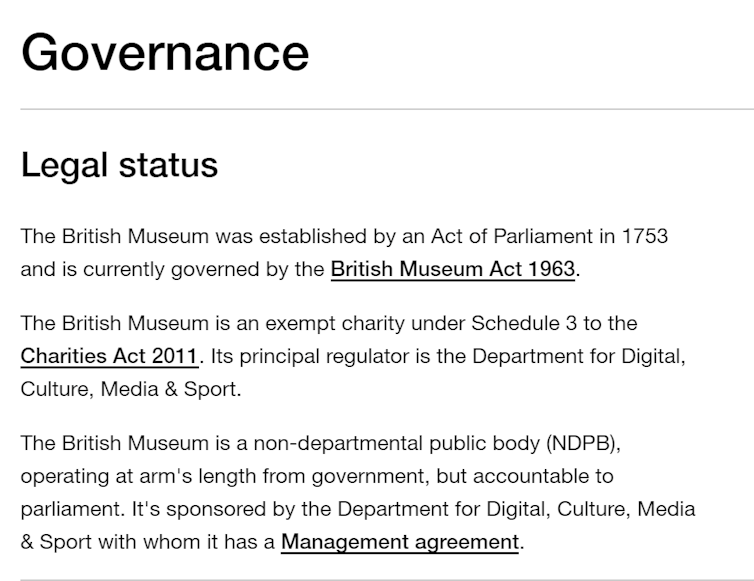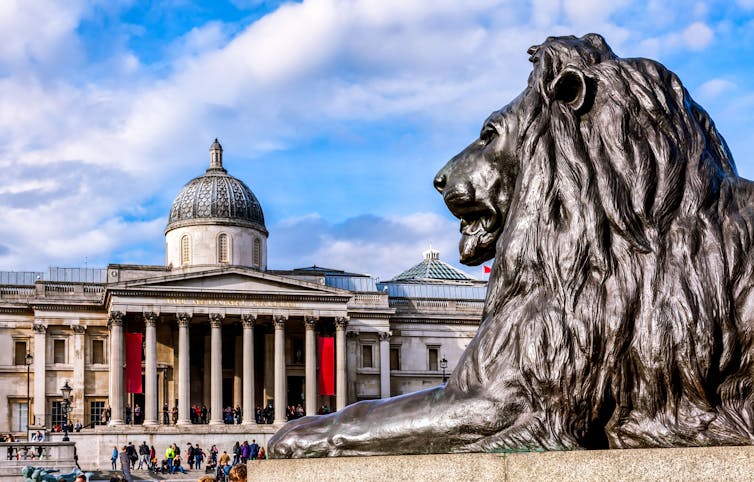Mary Beard and the British Museum – who runs the UK's cultural institutions?

One of Britain’s great cultural institutions: the British Museum in London.
Claudio Divizia via Shutterstock
Kim-Marie Spence, Solent University
Many of those within academic and cultural circles in the UK were shocked and angered recently when it was reported that the government had refused to allow the nomination of one of the country’s leading public intellectuals to the board of trustees of the British Museum. Mary Beard was rejected, reportedly by order of the prime minister’s office, apparently because of her outspoken pro-European Union views.
To put this into context, No 10 is reported to have rejected someone whose CV reads as follows: Dame Commander of the British Empire, professor of classics at Cambridge University, Royal Academy of Arts professor of ancient literature and classics editor of The Times Literary Supplement. And this, apparently, because she takes an opposing view on one of the key issues of the day.
Former BBC World Service boss Sir John Tusa – himself a former trustee of the British Museum – condemned the decision, calling it an “absolute scandal”. It has been reported that the British Museum will defy the governmentand that Beard will still be appointed to one of five trustee positions that the museum controls itself (the government and the Queen control the other 20).
But the story of the government’s rejection of Beard’s candidacy is not just about escalating political polarisation within Britain but also a deterioration of the “arm’s-length principle” that has characterised the governance of cultural institutions in the UK for many years.
It’s a principle that is designed to protect institutions like the British Museum from politicisation. The argument is that it protects both parties, preventing important cultural institutions from becoming politicised and at the same time protecting the government from any backlash due to the inherent heterodoxy and freedom of expression within arts and culture.
The British Museum itself cites arm’s length as its governance principle, as you can see from this extract below:

How the British Museum is governed.
British Museum
In their much cited 1989 discussion of cultural funding practices, Canadian academics Harry Hillman-Chartrand and Claire McCaughey noted that:
having been appointed by the government of the day, trustees are expected to fulfil their grant-giving duties independent of the day-to-day interests of the party in power, much like the trustee of a blind trust.
Guarantee of independence
According to the British Museum Act (1963), out of the British Museum’s 25 trustees, 20 are appointed by the Crown – one by the queen, 15 by the prime minister and four by the culture secretary. Refusing to nominate Beard – while distasteful on the part of the government – might not strictly be a violation of the arm’s-length principle, because the museum can still insist on having Beard as one of its five nominees. The real violation would be if the choice of the trustees was not allowed as a result of further government intervention.
Most public cultural institutions do not have the options available to the British Museum. The arms’s-length principle has been undermined within the realm of British cultural governance for some time. Of the four institutions covered by the 1992 Museums and Galleries Act, only the trustees of the Tate Gallery and the National Gallery are allowed one nomination – but it must be a trustee from the other institution’s board (so the National Gallery chooses a trustee from the Tate Gallery’s board and vice versa).

National Portrait Gallery is allowed to nominate only one of its trustees.
FenlioQ via Shutterstock
In comparable institutions covered by other acts, for example the V&A Museum, all trustees are appointed by the prime minister’s office. So the wholesale appointment of trustees to cultural institutions by the government is not unusual and there is no scope for the kind of action or show of independence that the British Museum trustees are planning to take.
Here lies the danger – the arm’s length maintained between the government’s political interests and those of trustees of cultural institutions has – in essence – become closer. It now appears to be more of a handshake.
A limited model
The arm’s-length principle is more commonly discussed in terms of funding and in relation to the UK’s various Arts Councils. The Arts Council of Great Britain – now the Arts Council of England (ACE) – which was created in 1946, was arguably the world’s first arm’s-length council.
Despite this model finding its way into governance in countries around the world, such as Australia and New Zealand, the ACE model has been found wanting for its inattention to issues of systemic exclusion on race, class, gender and even location. One criticism of ACE’s recently released ten-year strategy, ACE in a Hole?, focused on the values it needs to espouse rather than any particular initiative.
The two most important, as far as I am concerned, are trust and accountability. The report’s authors highlight the lack of accountability and trust between ACE, the government and the various cultural communities. These criticisms echo one another – even as far back as 1997, academic Ruth Blandina-Quinn, whose work has focused on arts policy, noted increasing politicisation of the Arts Council. This, she wrote, had been exacerbated by the lack of criteria for appointment, as well as political appointees, a lack of transparency, a lack of accountability to the artistic community and increasingly closer ties with, and oversight by, the government.
While the public awaits the conclusion of the Mary Beard episode, it’s a good time to examine and debate whether arm’s length is still the principle within cultural governance. Criticisms about systemic inequity within the arts and cultural industries abound and have not been helped by the exclusion of one of the UK’s leading female public intellectuals.
It’s a slippery slope – Britain’s cultural institutions must be safeguarded from becoming political footballs where a person’s opinions alone are grounds for exclusion from governing bodies. The debate, as we wait to see whether Mary Beard is allowed to take up her place in the British Museum’s trustees, is what a country whose galleries and arts organisations are directly controlled by government placeholders will look like.
Kim-Marie Spence, Postdoctoral Researcher (and Adjunct Lecturer, University of the West Indies), Solent University
This article is republished from The Conversation under a Creative Commons license. Read the original article.